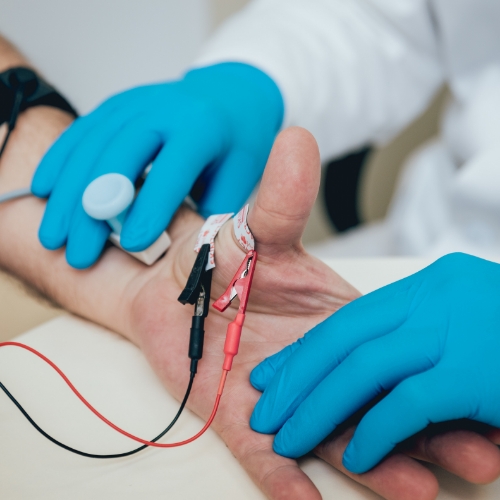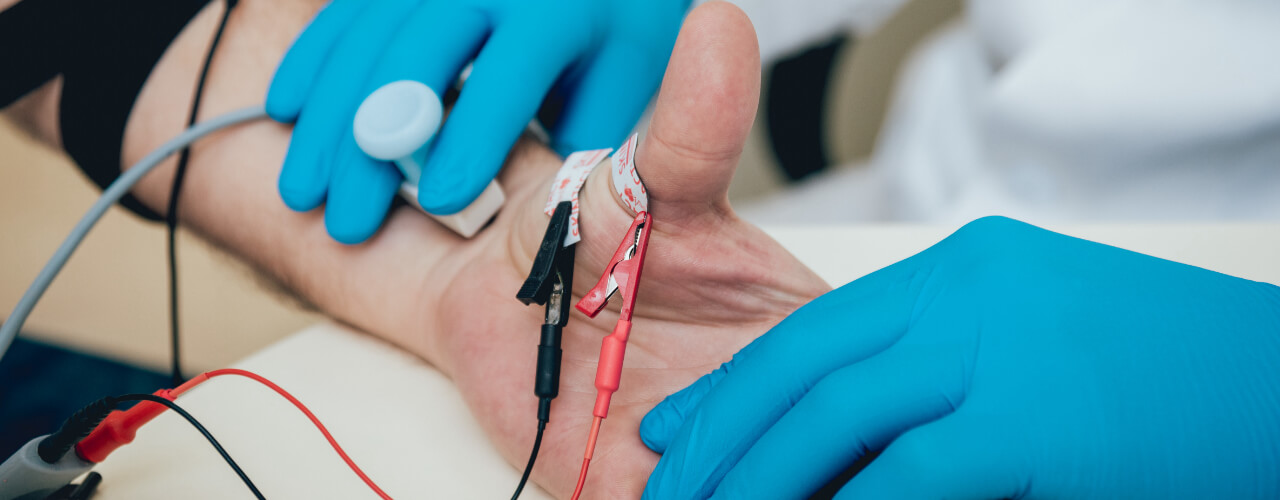What Is An EMG?
EMG, also known as Electromyography, is a diagnostic test used as a way to analyze muscle health and their corresponding nerve cells. EMG testing can help determine if you have muscle dysfunction, nerve dysfunction, or other issues regarding the signal transmission between your muscles and nerves.
What Are Nerve Conduction Studies?
Nerve Conduction Testing is a similar diagnostic test to Electromyography (EMG), although there are a few key differences. Nerve Conduction Testing uses surface electrodes, as opposed to needle electrodes, and therefore is a less invasive procedure. Surface electrodes are stickers that are placed to the skin’s surface on top of the affected area.
With these electrodes, we can measure the speed and strength of the messages being sent between your muscles and nerves, in order to determine the issue and the best course of treatment for your needs.
Why is EMG done?
The main reason why your physician would refer you to our Gunnison, Ephraim, Mount Pleasant, Richfield, and Manti, UT physical therapy locations is to diagnose a suspected disorder or dysfunction in either your muscles or nerves. Some signs that may indicate potential disorder or dysfunction include:
- Pain in the limbs
- Pain or cramping in the muscles
- Numbness
- Tingling
- Weakness in the muscles
There are a large number of conditions that EMG can help our physical therapists diagnose. These include, but are not limited to:

- Disorders that affect the nerve root, such as a herniated disc in the spine.
- Disorders of nerves outside the spinal cord (peripheral nerves), such as carpal tunnel syndrome or peripheral neuropathies.
- Muscle disorders, such as muscular dystrophy or polymyositis.
- Diseases affecting the connection between the nerve and the muscle, such as myasthenia gravis.
- Disorders that affect the motor neurons in the brain or spinal cord, such as amyotrophic lateral sclerosis or polio.
What can I expect from EMG?
When the needle electrode is inserted into the affected muscle, you may feel some slight discomfort, but it should not be painful. There may be some pain as the needle is removed, but that should disappear shortly after. You may be asked to move the affected area in certain ways or contract the affected muscle, in order to determine which signals are being affected and where the areas of inactivity are present.
You may notice some discomfort with movement, but our physical therapist will not ask you to make any extreme movements to the muscle. You may also be asked to change positions in the way you are sitting or lying down during the testing.
If you notice some soreness from the movement following the EMG, it should go away shortly. Our physical therapist can also provide you with remedies you can do at home to ease any discomfort.
After your EMG is complete, our physical therapist will analyze the EMG test and send the results to your physician. Your physician will review your results with you at your next appointment. If appropriate, our physical therapist will design a personalized treatment plan for your specific needs to help relieve your pain and correct your condition.
Do you think you could benefit from EMG? If so, don’t hesitate to contact Therapy West Physical Therapy + Sports Medicine today to get started on the first steps!
Your Next Steps…
Request An Appointment
Receive A Custom Treatment Plan
Work Hard and Progress In Your Recovery
Recover & Enjoy Life Pain-Free!

